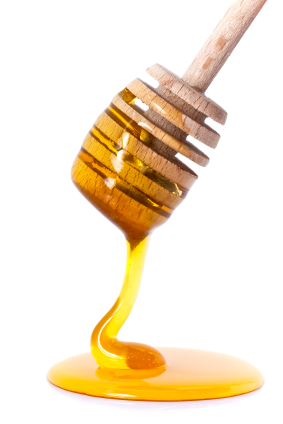DID YOU KNOW.....
- Honey bees must gather nectar from two million flowers to make one pound of honey.
- One bee would therefore have to fly around 90,000 miles - three times around the globe - to make one pound of honey.
- The average honey bee will actually make only one twelfth of a teaspoon of honey in its lifetime.
- A honey bee can fly as fast as 15 miles per hour.
- It takes one ounce of honey to fuel a bee's flight around the world.
- A honey bee visits 50 to 100 flowers during a collection trip.
- Worker bees are all female.
- Flowers have bright markings and strong smells to attract bees and other insects so that they will pollinate flowers. Some also have dark lines called 'honey guides' which scientists believe help insects find their way into the flowers.
- A colony of bees consists of tens of thousands of worker bees, one queen and sometimes drones (male bees).
- The honey bee is the only insect that produces food eaten by man.
- Honey has always been highly regarded as a medicine. It is thought to help everything from sore throats and digestive disorders to skin problems and hay fever.
- Honey has antiseptic properties and historically was often used as a dressing for wounds and a first aid treatment for burns and cuts.
- Honey lasts for ever - or nearly. An explorer who found a 2000 year old jar of honey in an Egyptian tomb said it tasted delicious!
- The natural fruit sugars in honey - fructose and glucose - are very quickly digested by the body. This is why sportsmen and athletes use honey to give them a natural energy boost.
- The Romans used honey instead of gold to pay their taxes.
- Honey bees have been producing honey in the same way for 150 million years.
- The bees' buzz is the sound made by their wings which beat 11,400 times per minute.
- Bees feed their larvae on pollen or 'cakes' made from pollen and saliva, using honey as a source of food during winter months. As they make more than they need, we humans can share the fruit of their labours.
- The term 'beeline' comes from the 'bee line' these clever insects make to the flower of their choice, using the shortest route possible.
- When a bee finds a good source of nectar it flies back to the hive and shows its friends where the nectar source is by doing a sort of dance positioning the flower in relation to the sun and the hive. This is known as the 'waggle dance.'
- In Ancient Egypt honey had a role in births, deaths and marriages; it provided the energy and inspiration to create a child, was used to make special honey cakes as an offering to placate the gods and was an ingredient in embalming fluids.
- Nearly one million tonnes of honey is produced worldwide every year.
- Honey's ability to attract and retain moisture means that it has long been used as a beauty treatment. It was part of Cleopatra's daily beauty ritual.
- In India , Krishna, as an avatar of Vishnu, has a blue bee in the middle of his forehead. Soma, the moon, is called a bee.
- The Greek Great Mother was known as the Queen Bee, and her priestesses were called Mellisae, the Bees.
- In Celtic myths, bees possess a secret wisdom garnered from the other world.
- In Australia and Africa bees are found as tribal totems.


